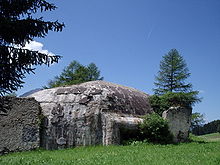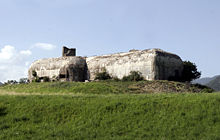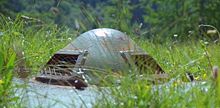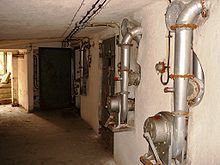
Alpine Wall
Encyclopedia
The Alpine Wall was a system of fortifications along Italy
's northern frontier built in the years leading up to World War II
. Built at the direction of Italian dictator
Benito Mussolini
, the defensive line faced France
, Switzerland
, Austria
and Yugoslavia
.
The Alpine line was similar in concept to other frontier fortifications of the same era, including the Maginot Line
of France, the Siegfried Line
of Germany, and the National Redoubt of Switzerland
. Italy's land frontiers were in most places mountainous and easily defended, but in the years leading up to World War II, Italy's relations with its neighbours were uneasy. Even in its dealings with its German ally, Italy was concerned about German ambitions towards its majority German inhabited province of South Tyrol
. Due to the rugged nature of the Alpine frontier, defences were confined to passes and observation posts in accessible locations.

 Work on the Alpine Wall began in 1931, intended to cover an arc from the Mediterranean
Work on the Alpine Wall began in 1931, intended to cover an arc from the Mediterranean
coast at Ventimiglia
in the west to Fiume
on the Adriatic
coast in the east. Three zones were designated at increasing distances from the frontier:
Three types of fortifications were provided:
The work, which was carried out in secrecy using Italian labor, was a significant economic burden, resulting in 208 opere with 647 machine guns and fifty artillery pieces. Construction continued until 1942. The forts were armed with a mixture of new weaponry and older equipment from World War I
. Provisions were made to deal with the use of poison gas. Much of the armour was obtained from Germany in compensation for Italian military ventures on behalf of the Axis
.
. During the Italian invasion of France
in 1940, some western forts such as Fort Chaberton exchanged fire with their French counterparts of the Alpine Line
. Chaberton was hit by French 280mm field mortars and suffered disabling damage. In addition, some Alpine Wall fortifications were used defensively by the Germans in 1944.
to that state. The 1947 Paris Peace Treaty
forbade the construction or expansion of fortifications within twenty kilometers of the border. However, with Italy's membership in NATO, construction began on a new defensive line from Austria to the Adriatic along the Yugoslavian border along the Natisone
and Tagliamento rivers. The new line used tank turrets in a manner similar to German defences during the previous conflict, allowing 360 degree traverse and a high rate of fire. By 1976 this system was still considered useful in any conflict short of nuclear war.
brought an end to the usefulness of the Alpine Wall. The emplacements were stripped and sealed in 1991-1992. No functional fortifications have been preserved.


 The fortifications were primarily constructed in the flanking heights of the valleys, with works within the valleys only where they were sufficiently wide. Anti-tank guns, artillery and machine guns were trained on prepared fields of fire, with observation stations at higher points. Shelters for infantry were located rearwards. A system of communications links and roads, or for higher locations, ropeway
The fortifications were primarily constructed in the flanking heights of the valleys, with works within the valleys only where they were sufficiently wide. Anti-tank guns, artillery and machine guns were trained on prepared fields of fire, with observation stations at higher points. Shelters for infantry were located rearwards. A system of communications links and roads, or for higher locations, ropeway
s were provided for communication and supply.
Fortifications were camouflage
d so that they appeared to blend with the surroundings, whether doors or embrasures were open or closed. Emergency escape routes were also provided.
Usual armament included:
Fortifications were usually surrounded by minefields
and barbed wire
. Where feasible, an anti-tank ditch was provided.
Italy
Italy , officially the Italian Republic languages]] under the European Charter for Regional or Minority Languages. In each of these, Italy's official name is as follows:;;;;;;;;), is a unitary parliamentary republic in South-Central Europe. To the north it borders France, Switzerland, Austria and...
's northern frontier built in the years leading up to World War II
World War II
World War II, or the Second World War , was a global conflict lasting from 1939 to 1945, involving most of the world's nations—including all of the great powers—eventually forming two opposing military alliances: the Allies and the Axis...
. Built at the direction of Italian dictator
Dictator
A dictator is a ruler who assumes sole and absolute power but without hereditary ascension such as an absolute monarch. When other states call the head of state of a particular state a dictator, that state is called a dictatorship...
Benito Mussolini
Benito Mussolini
Benito Amilcare Andrea Mussolini was an Italian politician who led the National Fascist Party and is credited with being one of the key figures in the creation of Fascism....
, the defensive line faced France
French Third Republic
The French Third Republic was the republican government of France from 1870, when the Second French Empire collapsed due to the French defeat in the Franco-Prussian War, to 1940, when France was overrun by Nazi Germany during World War II, resulting in the German and Italian occupations of France...
, Switzerland
Switzerland
Switzerland name of one of the Swiss cantons. ; ; ; or ), in its full name the Swiss Confederation , is a federal republic consisting of 26 cantons, with Bern as the seat of the federal authorities. The country is situated in Western Europe,Or Central Europe depending on the definition....
, Austria
Austria
Austria , officially the Republic of Austria , is a landlocked country of roughly 8.4 million people in Central Europe. It is bordered by the Czech Republic and Germany to the north, Slovakia and Hungary to the east, Slovenia and Italy to the south, and Switzerland and Liechtenstein to the...
and Yugoslavia
Kingdom of Yugoslavia
The Kingdom of Yugoslavia was a state stretching from the Western Balkans to Central Europe which existed during the often-tumultuous interwar era of 1918–1941...
.
The Alpine line was similar in concept to other frontier fortifications of the same era, including the Maginot Line
Maginot Line
The Maginot Line , named after the French Minister of War André Maginot, was a line of concrete fortifications, tank obstacles, artillery casemates, machine gun posts, and other defences, which France constructed along its borders with Germany and Italy, in light of its experience in World War I,...
of France, the Siegfried Line
Siegfried Line
The original Siegfried line was a line of defensive forts and tank defences built by Germany as a section of the Hindenburg Line 1916–1917 in northern France during World War I...
of Germany, and the National Redoubt of Switzerland
National Redoubt (Switzerland)
The Swiss National Redoubt was a defensive plan developed by the Swiss government beginning in the 1880s to respond to foreign invasion. In the opening years of World War II the plan was expanded and refined to deal with a potential German invasion. The German plan, Operation Tannenbaum, was real,...
. Italy's land frontiers were in most places mountainous and easily defended, but in the years leading up to World War II, Italy's relations with its neighbours were uneasy. Even in its dealings with its German ally, Italy was concerned about German ambitions towards its majority German inhabited province of South Tyrol
South Tyrol
South Tyrol , also known by its Italian name Alto Adige, is an autonomous province in northern Italy. It is one of the two autonomous provinces that make up the autonomous region of Trentino-Alto Adige/Südtirol. The province has an area of and a total population of more than 500,000 inhabitants...
. Due to the rugged nature of the Alpine frontier, defences were confined to passes and observation posts in accessible locations.
History


Mediterranean Sea
The Mediterranean Sea is a sea connected to the Atlantic Ocean surrounded by the Mediterranean region and almost completely enclosed by land: on the north by Anatolia and Europe, on the south by North Africa, and on the east by the Levant...
coast at Ventimiglia
Ventimiglia
Ventimiglia is a city and comune in Liguria, northern Italy, in the province of Imperia. It is located southwest of Genoa by rail, and 7 km from the French-Italian border, on the Gulf of Genoa, having a small harbour at the mouth of the Roia River, which divides the town into two parts...
in the west to Fiume
Rijeka
Rijeka is the principal seaport and the third largest city in Croatia . It is located on Kvarner Bay, an inlet of the Adriatic Sea and has a population of 128,735 inhabitants...
on the Adriatic
Adriatic Sea
The Adriatic Sea is a body of water separating the Italian Peninsula from the Balkan peninsula, and the system of the Apennine Mountains from that of the Dinaric Alps and adjacent ranges...
coast in the east. Three zones were designated at increasing distances from the frontier:
- "Zone of Security": Initial contact with the enemy.
- "Zone of Resistance": Heavier fortifications capable of resistance in isolation.
- "Zone of Alignment": Assembly area for counterattack, into which the enemy was to be directed.
Three types of fortifications were provided:
- "Type A": The largest fortifications, generally built into mountainsides.
- "Type B": Smaller point-defence fortifications.
- "Type C": Widely-distributed shelters and rallying points
The work, which was carried out in secrecy using Italian labor, was a significant economic burden, resulting in 208 opere with 647 machine guns and fifty artillery pieces. Construction continued until 1942. The forts were armed with a mixture of new weaponry and older equipment from World War I
World War I
World War I , which was predominantly called the World War or the Great War from its occurrence until 1939, and the First World War or World War I thereafter, was a major war centred in Europe that began on 28 July 1914 and lasted until 11 November 1918...
. Provisions were made to deal with the use of poison gas. Much of the armour was obtained from Germany in compensation for Italian military ventures on behalf of the Axis
Axis Powers
The Axis powers , also known as the Axis alliance, Axis nations, Axis countries, or just the Axis, was an alignment of great powers during the mid-20th century that fought World War II against the Allies. It began in 1936 with treaties of friendship between Germany and Italy and between Germany and...
.
The Alpine Wall during World War II
Little use was made of the Alpine Wall during World War IIWorld War II
World War II, or the Second World War , was a global conflict lasting from 1939 to 1945, involving most of the world's nations—including all of the great powers—eventually forming two opposing military alliances: the Allies and the Axis...
. During the Italian invasion of France
Italian invasion of France
The Italian invasion of France in June 1940 was a small-scale invasion that started near the end of the Battle of France during World War II. The goal of the Italian offensive was to take control of the Alps mountain range and the region around Nice, and to win the colonies in North Africa...
in 1940, some western forts such as Fort Chaberton exchanged fire with their French counterparts of the Alpine Line
Alpine Line
The Alpine Line or Little Maginot Line was the component of the Maginot Line that defended the southeastern portion of France...
. Chaberton was hit by French 280mm field mortars and suffered disabling damage. In addition, some Alpine Wall fortifications were used defensively by the Germans in 1944.
After World War II
At the end of the conflict, some of the western fortifications were destroyed, while portions of the eastern works were transferred to Yugoslavia as part of the transfer of FriuliFriuli
Friuli is an area of northeastern Italy with its own particular cultural and historical identity. It comprises the major part of the autonomous region Friuli-Venezia Giulia, i.e. the province of Udine, Pordenone, Gorizia, excluding Trieste...
to that state. The 1947 Paris Peace Treaty
Paris Peace Treaties, 1947
The Paris Peace Conference resulted in the Paris Peace Treaties signed on February 10, 1947. The victorious wartime Allied powers negotiated the details of treaties with Italy, Romania, Hungary, Bulgaria, and Finland .The...
forbade the construction or expansion of fortifications within twenty kilometers of the border. However, with Italy's membership in NATO, construction began on a new defensive line from Austria to the Adriatic along the Yugoslavian border along the Natisone
Natisone
The Natisone is a river that flows for some time as a border river between Slovenia and Italy, continues in Slovenia and then crosses the border and continues in Eastern Friuli, in north-eastern Italy...
and Tagliamento rivers. The new line used tank turrets in a manner similar to German defences during the previous conflict, allowing 360 degree traverse and a high rate of fire. By 1976 this system was still considered useful in any conflict short of nuclear war.
Abandonment
The end of the Cold WarCold War
The Cold War was the continuing state from roughly 1946 to 1991 of political conflict, military tension, proxy wars, and economic competition between the Communist World—primarily the Soviet Union and its satellite states and allies—and the powers of the Western world, primarily the United States...
brought an end to the usefulness of the Alpine Wall. The emplacements were stripped and sealed in 1991-1992. No functional fortifications have been preserved.
Arrangement



Ropeway
A ropeway is a form of naval lifting device used to transport light stores and equipment across rivers or ravines. It comprises a jackstay, slung between two sheers or gyns, one at either end, from which is suspended a block and tackle, that is free to travel along the rope and hauled back and...
s were provided for communication and supply.
Fortifications
The individual fortifications were typically built in rock on valley sides. Where this was not suitable, concrete was used for protection, with a minimum of openings and three to five metres of concrete thickness. Combat blocks were to the front, with ammunition rooms behind. Underground galleries connected the combat blocks and their support areas, such as the utility rooms, barracks, storage and command centres, with the main entry farthest to the rear. Combat areas were isolated from the rest of the structure by gas-tight doorways. Units built after 1939 were designed to operate independently, cut off from utilities and supplies.Fortifications were camouflage
Camouflage
Camouflage is a method of concealment that allows an otherwise visible animal, military vehicle, or other object to remain unnoticed, by blending with its environment. Examples include a leopard's spotted coat, the battledress of a modern soldier and a leaf-mimic butterfly...
d so that they appeared to blend with the surroundings, whether doors or embrasures were open or closed. Emergency escape routes were also provided.
Armament
Typically an anti-tank gun and a number of machine guns. Post-war units used tank turrets.Usual armament included:
- Machine gun, Fiat 35Fiat-Revelli Modello 1935The Fiat-Revelli 35 was a revised version of the Modello 1914, which had equipped the Italian Army of the Great War. The Modello 14 seems to have begun the Italian fascination with over-complicated loading systems and the need for lubricating rounds to prevent jamming, which often had the opposite...
in casemate or metal turret - Machine gun, Breda 30Breda 30The Fucile Mitragliatore Breda modello 30 was the standard light machine gun of the Royal Italian Army during World War II.The Breda 30 was rather unique for a light machine gun. It is magazine fed from the right side and the magazine was attached to the gun and was loaded using brass or steel 20...
and Breda M37Breda M37The Breda Modello 37 was an Italian heavy machine gun adopted in 1937. It was the standard machine gun for the Royal Italian Army during World War II...
, for defense of entries to the fortifications - Gun 57/43 RM mod. 887 on naval mounts
- Gun 75/43, ball mount in 10cm steel slab
- Gun 47/32Cannone da 47/32 M35The Cannone da 47/32 M35 was an Austrian artillery piece produced under license in Italy during World War II. It was used both as an infantry gun and an anti-tank gun....
- Mortar 81mm mod. 35Brandt mle 27/31The Brandt mle 27/31 mortar was a regulation weapon of the French army during the Second World War. Designed by Edgar Brandt it was copied by numerous countries.-Description:...
- FlamethrowerFlamethrowerA flamethrower is a mechanical device designed to project a long controllable stream of fire.Some flamethrowers project a stream of ignited flammable liquid; some project a long gas flame. Most military flamethrowers use liquids, but commercial flamethrowers tend to use high-pressure propane and...
Fortifications were usually surrounded by minefields
Land mine
A land mine is usually a weight-triggered explosive device which is intended to damage a target—either human or inanimate—by means of a blast and/or fragment impact....
and barbed wire
Barbed wire
Barbed wire, also known as barb wire , is a type of fencing wire constructed with sharp edges or points arranged at intervals along the strand. It is used to construct inexpensive fences and is used atop walls surrounding secured property...
. Where feasible, an anti-tank ditch was provided.
See also
- Maginot LineMaginot LineThe Maginot Line , named after the French Minister of War André Maginot, was a line of concrete fortifications, tank obstacles, artillery casemates, machine gun posts, and other defences, which France constructed along its borders with Germany and Italy, in light of its experience in World War I,...
- Siegfried LineSiegfried LineThe original Siegfried line was a line of defensive forts and tank defences built by Germany as a section of the Hindenburg Line 1916–1917 in northern France during World War I...
- Atlantic WallAtlantic WallThe Atlantic Wall was an extensive system of coastal fortifications built by Nazi Germany between 1942 and 1944 along the western coast of Europe as a defense against an anticipated Allied invasion of the mainland continent from Great Britain.-History:On March 23, 1942 Führer Directive Number 40...
- Czechoslovak border fortificationsCzechoslovak border fortificationsThe Czechoslovak government built a system of border fortifications from 1935 to 1938 as a defensive countermeasure against the rising threat of Nazi Germany that later materialized in the German offensive plan called Fall Grün...

